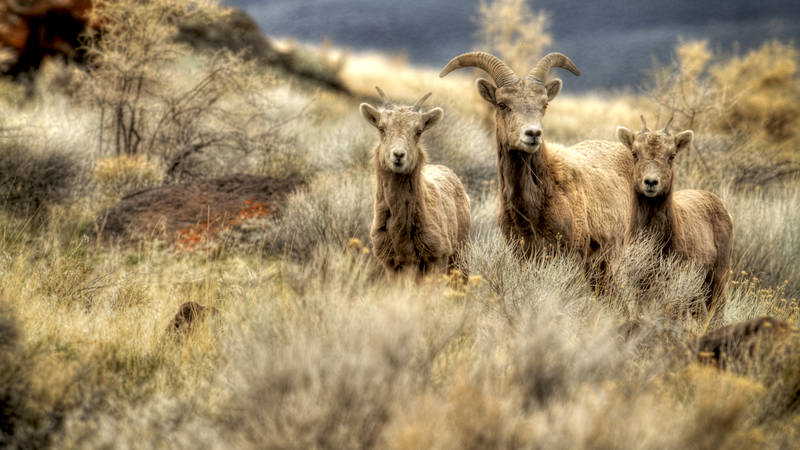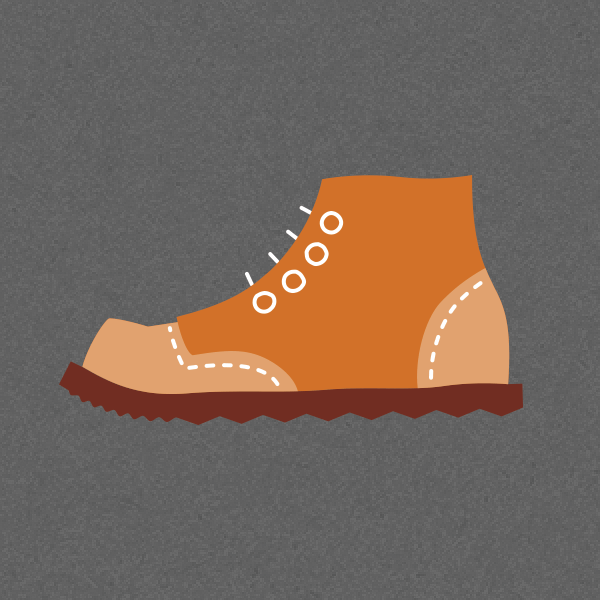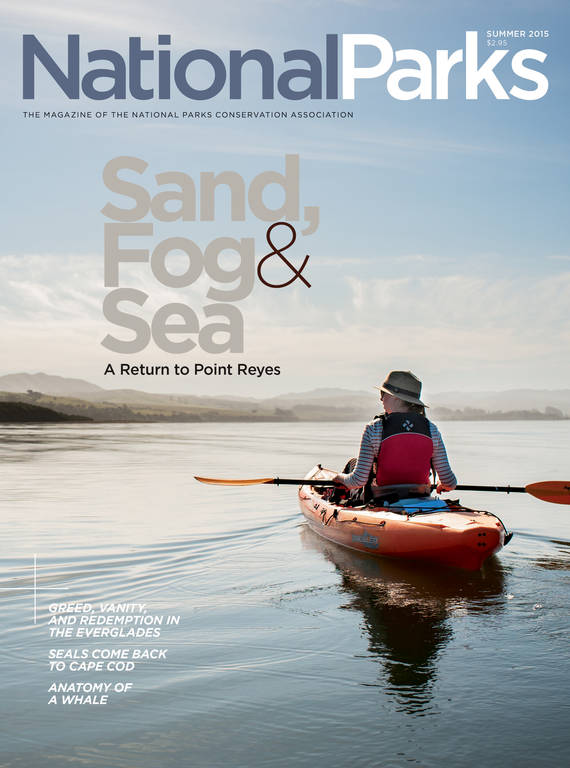Summer 2015
A Front-Row Seat
A naturalist watches as seals return to Cape Cod National Seashore—and marvels at the human response.
Sometimes, when the wind is right, I can hear the seals from my couch. Rowdy ghosts. Grumpy moaners. They snort and howl from the exposed sandbar four miles away as I sip coffee, window cracked and a breeze on my neck. Crap, I think. I’ve got to get out there.
I live on the edge of the Cape Cod National Seashore, in Massachusetts, out near the end of this land that hooks into the North Atlantic. Year-round. Through stifling, crowded August and cold, deserted February. I’m a washashore. I moved here from the Olympic Peninsula of Washington State. I moved here for love. The place itself didn’t draw me east. In fact, I had a bit of a westerner’s reluctance to praise anything on the Atlantic, but it didn’t take long to fall for dunes and fishing boats and churches made into libraries and homes made into art galleries and the summer thrum of New York transplanted to narrow, shambly streets and the quiet, healing expanse of winter, when woods and shores and bars are returned to us, the year-rounders.
The gray seals are washashores, too, in a way. At least in this small fold of time.
If you run into someone who was last here ten years ago or if you ask old-timers staring at all the snouts and rugby-ball-like heads bobbing along Nauset Beach, you might catch them muttering something along the lines of, It wasn’t like this back in the day. They’re right.
It’s not that they overlooked the seals. It’s hard to overlook an 800-pound male gray seal. The seals really weren’t here. They weren’t here in the 1950s or ’60s or even the ’70s. We wiped them out. Extirpated them from our waters.
Seals used to have a price on their heads in Massachusetts and Maine. From 1888 to 1962, with a slight gap around the turn of the century, if you turned in a seal nose, you could collect up to $5 from the state of Massachusetts.
No one knows for sure just how many were killed. Something in the tens of thousands, say the best estimates. It was done, they said, to protect fish stocks for fishermen. We did the same thing with bald eagles in Alaska. But in 1965 we decided that eliminating an entire population might not be the best idea, and seals were given legal protection by the state. “No person shall willfully detain, hunt, kill or injure a gray seal,” the statute reads. In 1972, the federal Marine Mammal Protection Act extended protections even further.
These laws said that we value seals as a foundational part of our world. The sea and shore were theirs before they were ours, after all. Archaeologists have found gray seal remains in middens on Martha’s Vineyard dating back 4,000 years.
And now they’re coming back. For the past 15 years, I’ve worked as a naturalist on the Cape and helped a local organization that responds to marine mammals stranded on shore, so some of my fascination is professional. The return of the seals is part of a larger story of rewilding, like black bears lumbering through Connecticut suburbs, coyotes in Los Angeles, and wolves in Yellowstone. But some of my fascination is that of anyone gawking at dramatic change. We have, here, a front-row seat to a riveting show, and I don’t want to miss a thing.

Cape Cod National Seashore
Famous for its windswept beaches and spectacular views, Cape Cod National Seashore offers a quintessentially New England experience, from Nauset Lighthouse to the seaside cottages that nestle among the dunes.…
See more ›“LET’S JUMP INTO THE CAR, HONEY, and head straight for the Cape,” wrote Stanley Kunitz in his poem “Route Six.”
During the summer it feels like everyone on the Eastern Seaboard is doing just that. The sand is pinned by umbrellas, patched by towels. The highway running the Cape’s spine is a droning hazard punctuated by ambulances trying to staunch the disasters of aggressive vacationing: heatstroke, bike accident, alcohol poisoning. Beaches close because of high bacteria counts. Too many people.
But there’s still a rind of wildness on this popular vacation land—trails where I can walk and not see anyone, even on the Fourth of July.
In 1961, President Kennedy established the Cape Cod National Seashore and saved the place from becoming an endless smear of hotels, floaty-toy emporiums, and private estates. More than 40,000 acres of scrub oak, pitch pine, dune, cranberry bog, and shore at the far end of the Cape. Ticks and greenbriar and poison ivy. Fisher cats. Three years ago, for a few weeks, a bear.
The city dwellers’ love of the beach isn’t all bad. They bring their own gifts. I can track otters or snorkel through salt marsh and then bike a mile and eat at a Zagat-rated restaurant, see art, catch a show, attend a reading by a Pulitzer-winning author.
But the dance of amusement and wildness and infrastructure can lead to deeply confusing snarls.
Did you know that the coyotes here are bigger than those out west? Some people, biologists included, call them coywolves. Some love spotting them through the trees, triangular faces peering back. A kid in his yard got bitten a few years ago. Some people call the coyotes pests and want them killed.
And now the seals.
They are accused of dirtying the water, eating all the fish, luring in sharks. Some people love them. Ranger-led seal walks are booked full. Private seal tours are raking in cash. How do we understand the truth of it all? Who gets to judge what the return of the seals means, whether it’s good or bad?

9 Wildlife Success Stories
National parks provide critical habitat for a variety of animals—in some cases, they are the only places that threatened or endangered species have left to call home.
See more ›I SIT ON THE BEACH AND STARE AT SEALS. In all honesty, I have no idea what I’m looking at. No one really does, because this species is virtually unstudied on our shores. Biologists are trying to patch together a story that can be woven into all the other stories scribed into these sands: Henry David Thoreau’s, Mary Oliver’s, Eugene O’Neill’s, Hans Hoffmann’s, that of fishermen and whalers and salt-makers and Pilgrims and locals and vacationers.
There are a few points of certainty in what’s before me: 600 or so gray seals resting on the sandbar that’s exposed at low tide—the haul-out. Halichoerus grypus. The hook-nosed sea pig. The Nantucket horsehead. Males, females, juveniles, all howling, farting, and snoozing for the two hours that straddle low tide.
It has to be summer, because they use this site en masse only from May through, oh, maybe November. Likely it’s hot. Muggy. Sun glares down, bounces off the sand and the water, squints me. I don’t go on rainy days because the camera is expensive and visibility bad.
Best if it’s morning, because then the sun is behind me and the crowds haven’t yet gathered. It’s quiet in those early hours, and my blood pressure isn’t raised by someone doing something stupid: charge the herd, get in the water and swim toward the haul-out, throw a Frisbee into the mix.
Midday is an awful time to go. Too much sun and too many people. With my notebook, camera, and spotting scope, I’m conspicuous. A weird, distasteful mix churns me. I want to be left alone, yet I also want to be seen as something clearly more than a casual visitor. The feeling is akin to neediness, that ugly underbelly of love.
Fog is no good for observation, but I love sitting out near the seals on a still, foggy day. Then, the ghosts within them rise and roil and chill into me. There’s a secret fort of us, a blanket of fog arched overhead, and we are in this place together in a way that bright sun or stiff wind denies.
Evening can be nice, the crowds gone for dinner. But I don’t often go then. I want to be home for dinner, too. I want to be making a cocktail and sitting on the patio under the raggedy bamboo pergola we cut from a friend’s garden to create shade, the surf sounding over the hill and, sometimes, the seals.
CAPE COD IS GROUND ZERO for North American extraction. Extraction conjures up clear-cuts and strip mines and oil rigs, mostly western operations. But well before the Mayflower arrived in Cape Cod Bay, Basque fishermen pulled in riches of cod from these harbors and brought them back to the overfished shores of Europe. Early visitors to these shores describe rivers choked with migrating salmon and alewives. Bays were so full of whales that they terrified captains navigating small, tender wooden boats. It’s easy to chalk such stories up to exaggeration, but they might be more real than we care to admit. It’s not pleasant to look out at beautiful dunes and wavelets and think decimated.
The harbors of the Cape still have a few old boats making a living from the sea. My neighbor is a lobsterman. A few of the captains I work with on the whale-watch boats used to fish, as did their fathers. Here, on the docks, there’s a palpable mourning for a time gone by, for the days when catches were brought in by the ton and fortunes were made. The guys who got out before the crash are a bit less romantic. They talk about the long hours, the boom and bust of openings, the ways water and salt can wreck a body. Saw the writing on the wall, they say. Nope. Don’t miss it.
Poor fishermen, thrums the undercurrent of the town harbors. The government offers them buyouts so they’ll stop fishing. The government tries to regulate catch limits so they still have something to bring in. The towns celebrate them with memorials and on postcards with quaint paintings. Hanging on by a thread, the fishermen say. Salt of the earth, the tourists say.
And now, in this diminished sea, the gray seals have returned. They’re hauling out at certain locations on shore for rest and breeding. They’re begging at the fish piers. They’re foraging, moaning, snorting, splashing. And not everyone is happy about it.
But gray seals aren’t the only ones eating the fish: That list includes dolphins, whales, other fish, and people. Gray seals are, however, the most visible and perhaps the least apologetic. They’ll loll on their backs, munching away at a striped bass they’ve caught, in some cases right off your own line. And the sight of a seal thieving from a net provokes the mildest of fishermen to rage. We see them.
Aside from the brazen fish-nabbing, the shark attracting, and the beach stinking-up, they are making the shore less free than it’s ever been—as if miles roped off to protect piping plovers were bad enough. The fact that none of these things is entirely true is not the point.
Seals are a stand-in for all the changes on the Cape in the last 50 years—home prices on the rise, schools closing, year-round communities turned to seasonal tourist escapes. They’re a stand-in for all that makes it hard to make a life here.
Nuisance animal. Time for a cull. Too many, say some.
In the summer of 2011, six gray seals washed up on shore with bullets in them.
Truthfully, gray seals are our best scapegoat. Something about their bold curiosity when they look at us from the water. Something about their ability to vanish in a flash, then turn up where you never expected them. And the fact that they are thriving when so many of us are not.
How many seals are too many? How many were here before? What’s a healthy population? We don’t know. Even if we did, the ocean these seals are returning to is different from the one they swam through back in 2000 BCE, 1492, or even 1961. The water is warmer. There are fewer of some fish and more of others. There are more lines and nets and pots in the water. We don’t know what a healthy ecosystem looks like here anymore. We might never know.
Here is the real question: What happens when animals come back and force us to change the habits we’ve fallen into in their absence? Can we adapt? I don’t mean this in a theoretical or hypothetical way. When animals come back, when places break from civilization (grass pushing through cracks in abandoned parking lots, woodpeckers drilling into attics and nesting, foxes claiming the cave of an abandoned summer home’s understairs as den), are we happy?
If not… what are we doing? Why did we set aside this land? Does a park need a fence to keep what’s wild there contained within its boundaries? Does a park need a wildlife bouncer?
And what is wildness? The Cape Cod National Seashore is one of the few national park units that allows hunting within its borders. Deer season (please help control the ticks that are spreading Lyme disease). Turkey season (now that wild turkeys have made a comeback, please keep some of them off the highway where they strut and stop traffic). Rabbit season (my strawberries!). In pheasant season, the park trucks in and then releases birds for people to hunt. The kettle ponds are stocked with fish.
The park allows us a connection to how people once lived off the land here, before there were so many of us. Scrappy New Englanders grinding acorns for flour, mulching their gardens with eelgrass, making ink from oak galls, pretending cranberries aren’t bitter and mealy.
How do the seals fit in? The story is unfolding now, though the seals don’t care. They just are, and that itself is a remarkable and fascinating spectacle.
I PROP MY ELBOWS ON MY KNEES, doing my best to ignore the August flies biting my ankles. I hold my binoculars to my eyes and scan the herd. I’m looking for identifiable animals.
There’s a seal that’s distinctive: a female whose dark spots on paler underfur look, on her left neck, like San Juan Island. I fix the spot in my mind: at the water line, near the gull, toward the right side of the group. Switch from binos to camera, try to find her again, shoot the left profile, wait for her to turn to get her right. Look down to the notebook and record it: frame numbers, “UP” for unique pelage.
I see one with a weird red bump ballooning from its forehead (pox?), one with an elliptical scar on its back (almost surely a shark bite), one with a deep indentation around its neck which I squint at (fat roll or line wrapped around the neck and cutting in?).
It’s a neck wrap. The sun glints on a stray sprig of monofilament like an out-of-place whisker. When the seal turns, I can see the pink of raw flesh where the line cuts down through skin and blubber to muscle. I photograph it, write down the frame numbers to send to the local stranding network I volunteer for when I’m home. I can’t call them now because there’s no cell service at the haul-out.
No one will be able to help this seal. Too hard to capture and cut the gear off. But maybe by documenting how many seals have entanglements like this we can start talking about what’s happening. Maybe we can figure out where they’re getting entangled and why and how long they can live with non-degradable material around their necks. Maybe we can find a number for the harm we’re doing them.

National Parks
You can read this and other stories about history, nature, culture, art, conservation, travel, science and more in National Parks magazine. Your tax-deductible membership donation of $25 or more entitles…
See more ›Behind me, a docent for the Park Service is talking to people, narrating what they’re seeing. The docent program is only a few years old (the seals only set up on this haul-out in 2008), and the volunteers are dedicated. All summer, they give their time to the seals. They stand out in heat, in rain. They offer binoculars. They explain. They warn people to stay back. Sometimes, though, when I overhear them explaining what they see, I bristle.
How does she know the males prefer the outer edges? I see plenty in the center. How does he know—he’s wrong—all these seals breed on Muskeget Island? I’ve photographed animals here with brands on their backs they got as pups when they were born on Sable Island in Canada and who are seen back there in breeding season.
We want so badly to be able to offer sure answers to the mass of blubber on the beach. What are they saying? Why do they do that? We just don’t know. We have so many questions, and these seals defy certainty. Their story is complicated and unfolding, which is fascinating.
What is it like to live on the edge of a national park? Where do I start? With the gray seals. With the complicated scapegoat that hasn’t read the rules and is making us ask questions about the very nature of how we live, moaning about it the whole time.
About the author
-
 Elizabeth Bradfield Contributor
Elizabeth Bradfield ContributorELIZABETH BRADFIELD’S poetry has appeared in The New Yorker, The Atlantic, Orion, and The Believer; she is the author of the poetry collections Once Removed (forthcoming), Approaching Ice, and Interpretive Work. Bradfield still lives on Cape Cod, where she works as a naturalist. This essay will appear in Permanent Vacation: Twenty Writers on Work and Life in Our National Parks: Volume II, The East, to be published in Spring 2016.



